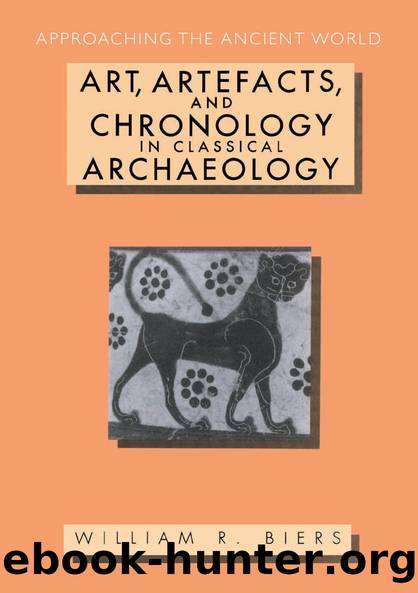Art, Artefacts and Chronology in Classical Archaeology by William R. Biers

Author:William R. Biers [Biers, William R.]
Language: eng
Format: epub
Tags: History, Ancient, General
ISBN: 9781135856991
Google: detxqSCLk0sC
Goodreads: 1609141
Publisher: Routledge
Published: 1992-11-12T00:00:00+00:00
Figure 25 Stamped amphora handle, scale 1:1. Museum of Art and Archaeology, University of Missouri, Columbia, Missouri
Many Greek vases from Athens of the Archaic and Classical periods, roughly from the third quarter of the sixth to the third quarter of the fifth century BC, have written inscriptions as part of their figured scenes. Many of these are menâs names in the formula âso-and-so kalosâ and are thus called âkalos names.â The word âkalosâ has a range of meanings in Greek including âbeautifulâ or âcomely,â and although the exact meaning of the term is debated, it has generally been thought that the youths named as kalos were aristocratic favorites of the day in the wealthy Athenian society that would be the main market for these highly-decorated vases. Some 300 names are known, and it would seem reasonable that in a relatively small society such as Athens of this period, some at least of the individuals named as âkalosâ in their youth might appear later as mature men in the historical record. If a particular person named as kalos on a vase could be identified with a later, dated, historical figure, then counting back to the period when the individual might be considered kalos would theoretically give a date for the vase. There are, however, only a few individuals about whom enough is known to allow this kind of computation, and there can be terrible confusion over identifications, given the ancient Greeksâ habit of naming their sons after their grandfathers and other relatives, thus providing for frequent repetition of names within a family. Furthermore, the rules governing the use of the term kalos are uncertain, particularly at what age and for how long a youth could be so described. Estimates of the length of time a youth could be considered kalos have ranged from the mid-teens, to even as late as 25. In general, the use of kalos names to determine chronology is considered too full of problems to be of much use, other than indicating relative chronology. For instance, if two vases painted by different painters both bear the same kalos names, they are likely to be more or less of the same date.18
A slightly different problem of identification confronts attempts to date ostraca, fragments of pottery on which were inscribed the names of prominent Athenians who were candidates for ostracisms held in the city during the fifth century BC. The institution of ostracism was a feature of Athenian democracy that was intended to allow the citizens to banish an individual whom they thought might be planning to seize the government and set himself up as a tyrant. It was in use for a relatively short period, about seventy years, and then was abandoned, for it quickly became a political tool for defeating an opponent. When a vote was taken for an ostracism, the citizens inscribed on their ostraca the names of the individuals they would like to see banished from the city. Occasionally, at least some of these were prepared
Download
This site does not store any files on its server. We only index and link to content provided by other sites. Please contact the content providers to delete copyright contents if any and email us, we'll remove relevant links or contents immediately.
| Central Africa | East Africa |
| North Africa | Southern Africa |
| West Africa | Algeria |
| Egypt | Ethiopia |
| Kenya | Nigeria |
| South Africa | Sudan |
| Zimbabwe |
Goodbye Paradise(3729)
Men at Arms by Terry Pratchett(2784)
Tobruk by Peter Fitzsimons(2447)
Arabs by Eugene Rogan(2263)
Borders by unknow(2232)
Pirate Alley by Terry McKnight(2187)
Belonging by Unknown(1812)
It's Our Turn to Eat by Michela Wrong(1688)
The Biafra Story by Frederick Forsyth(1616)
Botswana--Culture Smart! by Michael Main(1559)
The Source by James A. Michener(1540)
A Winter in Arabia by Freya Stark(1506)
Coffee: From Bean to Barista by Robert W. Thurston(1489)
Gandhi by Ramachandra Guha(1488)
The Falls by Unknown(1486)
Livingstone by Tim Jeal(1451)
The Shield and The Sword by Ernle Bradford(1369)
Africa: Altered States, Ordinary Miracles by Richard Dowden(1353)
Egyptian Mythology A Fascinating Guide to Understanding the Gods, Goddesses, Monsters, and Mortals (Greek Mythology - Norse Mythology - Egyptian Mythology) by Matt Clayton(1331)
